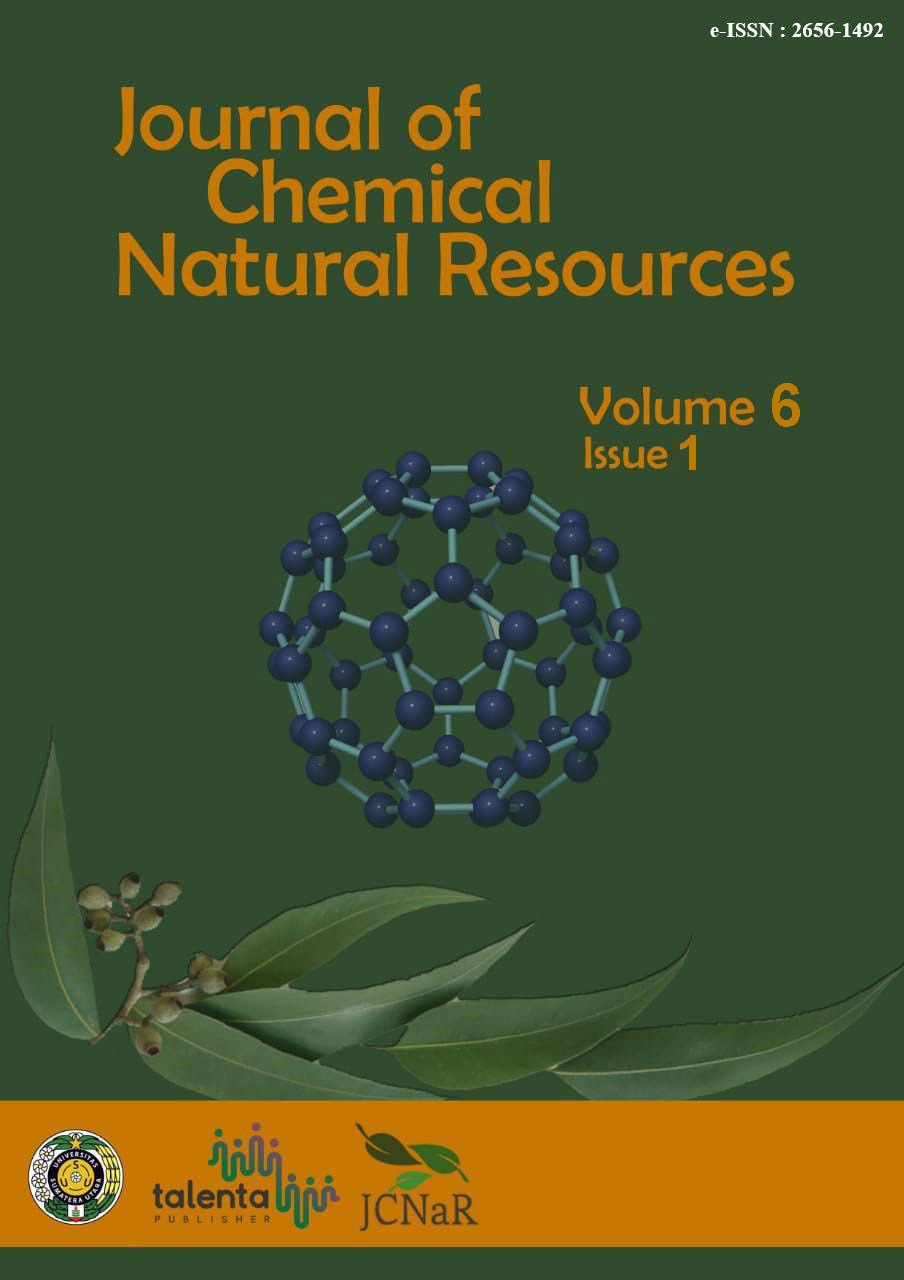Effect of Chitosan Addition on Porosity of Rice Husk Calcium Silicate Used for Free Fatty Acid Adsorbent from Palm Oil
DOI:
https://doi.org/10.32734/jcnar.v6i1.16222Keywords:
Calcium Silicate, Chitosan, Crude Palm Oil, Free Fatty Acid, Rice HuskAbstract
Studies have been done on developing calcium silicate pores derived from rice husk with and without including chitosan as a template. The chitosan solution was supplemented with sodium silicate derived from rice husk, and then CaCl2 was added. The calcium silicate was calcinated at 900ºC for 4 h. The calcium silicate obtained was characterized using X-ray diffraction (XRD), fourier transform infrared (FT-IR), and Brunauer-Emmett-Teller (BET)  analysis. The XRD analysis showed the presence of diffraction peaks corresponding to Wollastonite (CaSiO3) crystals, Wollastonite 2m (CaSiO3), Alite (Ca3SiO5), and larnite (Ca2SiO4). Next, the FT-IR spectrum exhibits Si-O-Si, Si-O-Ca, and Si-OH functional groups, suggesting the presence of calcium silicate material. The BET study of calcium silicate using chitosan templates revealed a pore size of 3.88 nm, a pore volume of 0.1577 cc/g, and a surface area of 81.1519 m2/g. The BET analysis results obtained differed from those of the BET analysis of calcium silicate conducted without using chitosan templates, which were 2.06 nm, 0.069 cc/g, and 13.531 m2/g, respectively. The developed mesoporous calcium silicate was employed as an adsorbent to decrease the concentrations of free fatty acids in palm oil. The acid-base titration method is used to evaluate quantities of free fatty acids. The results obtained from the computation of free fatty acid levels indicate a decline in the concentration of free fatty acids in palm oil. The concentration of free fatty acids derived from palm oil was 1.23%. Therefore, mesoporous calcium silicate-free fatty acids at a concentration of 1.06% resulted in an 86.1% reduction.
Downloads
References
Andriayani, Marpongahtun, Suharman, and A. Daulay, “Synthesis of mesoporous silica with ricinoleic methyl ester (Ricinus communis) as a template for adsorption copper (II) with optimizing Box-Behnken design,†Case Stud. Chem. Environ. Eng., vol. 7, no. October 2022, p. 100287, 2023, doi: 10.1016/j.cscee.2022.100287.
D. R. Mujiyanti, Nuryono, and E. S. Kunarti, “Sintesis dan Karakterisasi Silika Gel Dari Abu Sekam Padi Yang Dimobilisasi Dengan 3-(trimetoksisilil)-1-propantiol,†J. Sains dan Terap. Kim., vol. 4, no. 2, pp. 150–167, 2010.
A. Yazdani, H. R. Rezaie, and H. Ghassai, “Investigation of hydrothermal synthesis of wollastonite using silica and nano silica at different pressures,†J. Ceram. Process. Res., vol. 11, no. 3, pp. 348–353, 2010.
A. Zavala-Franco et al., “Assessing the aflatoxin B1 adsorption capacity between biosorbents using an in vitro multicompartmental model simulating the dynamic conditions in the gastrointestinal tract of poultry,†Toxins (Basel)., vol. 10, no. 11, pp. 1–16, 2018, doi: 10.3390/toxins10110484.
I. Mazmur, “Garam-Garam Logam Alkali Tanah Silikat Nano Pori Sebagai Adsorben Asam Lemak Bebas Dari Minyak Kelapa Sawit Kasar,†Universitas Sumatera Utra, 2016.
S. bima Sembiring and A. P. Siahaan, “Adsorption of Free Fatty Acids from Crude Palm Oil Using Calcium Silicate (CaSiO3) Adsorbent Glycerol Template,†J. Chem. Nat. Resour., vol. 5, no. 1, pp. 7–12, 2023, doi: 10.32734/jcnar.v5i1.11985.
J. Serafin and B. Dziejarski, “Application of isotherms models and error functions in activated carbon CO2 sorption processes,†Microporous Mesoporous Mater., vol. 354, no. January, 2023, doi: 10.1016/j.micromeso.2023.112513.
H. Wang, Q. Zhang, H. Yang, and H. Sun, “Synthesis and microwave dielectric properties of CaSiO3 nanopowder by the sol-gel process,†Ceram. Int., vol. 34, no. 6, pp. 1405–1408, 2008, doi: 10.1016/j.ceramint.2007.05.001.
Andriayani, “Sintesis Material Mesopori Silika dari Tetraetilortosilikat (TEOS) Menggunakan Natrium Risinoleat Sebagai Template dan 3-Aminopropilmetoksisilana (APMS) Sebagai Co- Structure Agent (CSDA),†Universitas Sumatera Utara, 2012.
F. Aritonang, “Pengaruh Penambahan Polietilen Glikol Terhadap Porositas Kalsium Silikat Dari Silika Abu Vulkanik Gunung Sinabung,†Universitas Sumatera Utara, 2017.
S. Uthaman, S. J. Lee, K. Cherukula, C. S. Cho, and I. K. Park, “Polysaccharide-coated magnetic nanoparticles for imaging and gene therapy,†Biomed Res. Int., vol. 2015, 2015, doi: 10.1155/2015/959175.
R. Silverstein, Spectrometric Identification of Organic Compounds. College of Environmental Scince & Forestry., 2005.

Downloads
Published
Issue
Section
License
Copyright (c) 2024 Journal of Chemical Natural Resources

This work is licensed under a Creative Commons Attribution-ShareAlike 4.0 International License.














